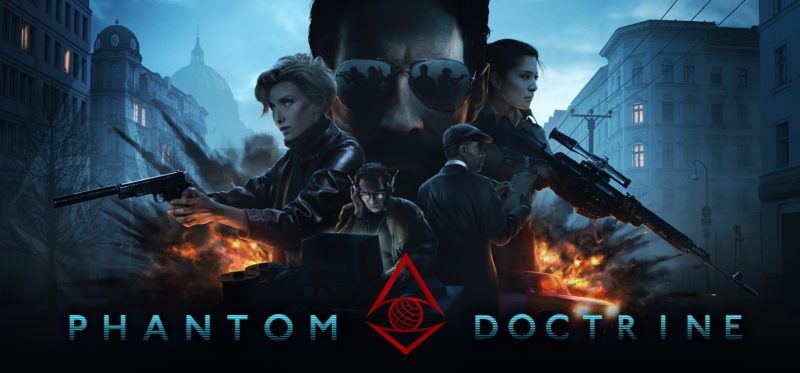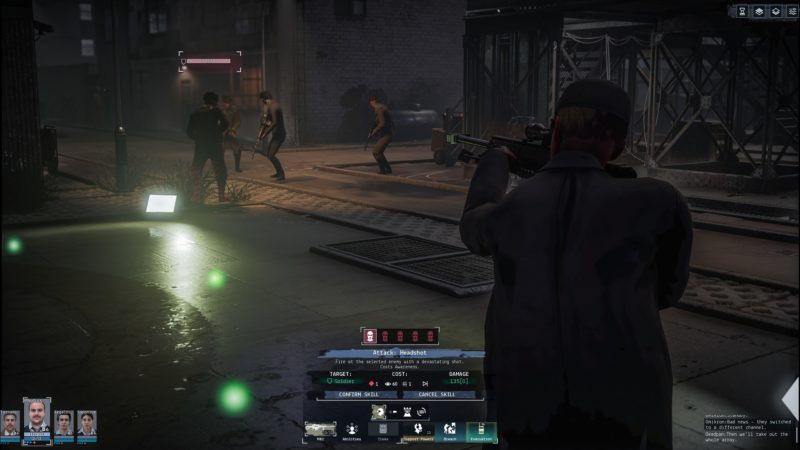
Phantom Doctrine by developer CreativeForge Games and publisher Good Shepherd Entertainment is a turn-based strategy game with a focus on spies. The best way I could sum it up would be secret agent chess. The main gameplay revolves around taking turns with your opponent to move your units on a grid-based map.
Stealth is very clearly the focus of this game. I tried to do a map with guns blazing and it resulted in all of my agents being severely wounded—on one of the first missions! Wounds that your spies acquire during missions can be healed at your base’s infirmary, but it takes a long time for their health to go back up to full. Also, the infirmary starts with only 2 slots open, so if you have more than 2 wounded agents, you need to either have them wait or continuously switch them out with the agents already in the infirmary. Luckily, you can use any agent outside of the infirmary, even if that agent is wounded. This resulted in me switching out agents who were close to full health rather than waiting for them to reach full health.

If an agent is killed during a mission, you will lose them for the rest of the game (unless you load a save before the agent was killed). Agents can also be left behind if you try to use the extraction option while said agents aren’t at the ‘evac’ point (you can only use the extraction option once). Agents left behind (as well as living witnesses) can increase your base’s danger meter. If the danger meter gets high enough, you have to either spend acquired funds to relocate the base or risk losing the game.

As you can probably guess by now, the ideal for each mission is to get all the way through it without having your agents be detected. One ability that every spy starts with, which I found useful for this, is ‘takedown.’ This ability allows you to knock-out/kill any enemy who’s remaining health is less than the remaining health of the agent using the ability without taking your agents out of stealth. I found this ability invaluable early in the game because any weapon that is fired without a silencer attached will reveal all of your units.

In-between missions, you can do various things at your base. To start with, you can view a list of your agents, send wounded agents to the infirmary, build items/upgrades, and access the investigation board and world map.
The world map allows you to advance time—allowing your agents in the infirmary to heal and upgrades to be built. The map also has multiple locations listed, some of which will be marked as suspicious, while others will be listed as potential new base locations (which is useful if your current base is compromised). You can send 1 or more agents to any location to see if it there actually is enemy activity in that area (sometime the map picks up false alarms). As you can probably guess, it takes time for your agents to move from your base to the assigned location—or from one location to another—so you need to allow time to advance for them to go to their destinations and—if necessary—conduct scouting operations.

If you detect an enemy spy in the location you send your agents to, you have the option to perform a scouting operation—provided you have met the criteria to do so. I recommend doing this as it makes the mission much easier to complete without raising the alarm. This can give your agents access to a disguise—thus making it that they can only be detected by an enemy spy—and/or allow them to see most/all of the map.
As you progress through the game, you will unlock clues to ongoing investigations. These clues are gathered either by assigning an agent to the investigation board or by capturing an enemy spy for interrogation during a mission (which is done by using the ‘takedown’ ability and then carrying their body to the evac point). As you gather clues, you can place them on the investigation board. Doing so will allow you to read gathered documents and try to find enemy agent codenames within the document. Any names you find are listed next to the document. If multiple documents have the same agent codename attached to them, you can link the documents together. The “objective” of this mode is to link enough clues together to discover the identity of a person central to the investigation. Completing an investigation places eligible recruits on the recruitment list. While these new agents don’t appear to cost anything to hire, every new agent you hire raises your base’s danger meter, so hiring multiple agents at once isn’t something I would recommend (unless you either have a low danger meter or you were planning on relocating anyways). Luckily, it doesn’t appear that agents will leave the recruitment list, so you don’t need to worry about missing out on a new agent because you waited too long to recruit them.

Overall, I enjoyed playing Phantom Doctrine. I should mention that this game has a multiplayer element as well, but I was unable to test it. I think a fair rating for this game would be 8/10.
Check Out the Phantom Doctrine Launch Trailer:
Phantom Doctrine is available for PlayStation 4, Xbox One, and PC via Steam.
PlayStation 4 Review
-
Overall Score - 8/108/10
I am a recent Computer Science/Game Development Programming Chapman University Graduate. I am a life long enthusiast of computer/video gaming and my favorite game genres are adventure, choice-driven stories, fighting, and racing. My favorite game/movie series include but aren't limited to 'Legend of Zelda'; 'Dragon Age'; 'Persona'; 'Sonic the Hedgehog'; 'Mario'; 'Metroid' ;'Megaman'; 'Naruto'; 'Batman'; 'Spiderman'; 'Star Wars'; and 'Star Trek.'





More Stories
I AM FUTURE Review for PlayStation 5
GTA Online: Money Fronts, HSW Race Bonuses, Free Hands-on Car Wash Property, Plus Much More
The Legend of Heroes: Trails beyond the Horizon Unveils Opening Movie Ahead of Jan. 15 Release Date